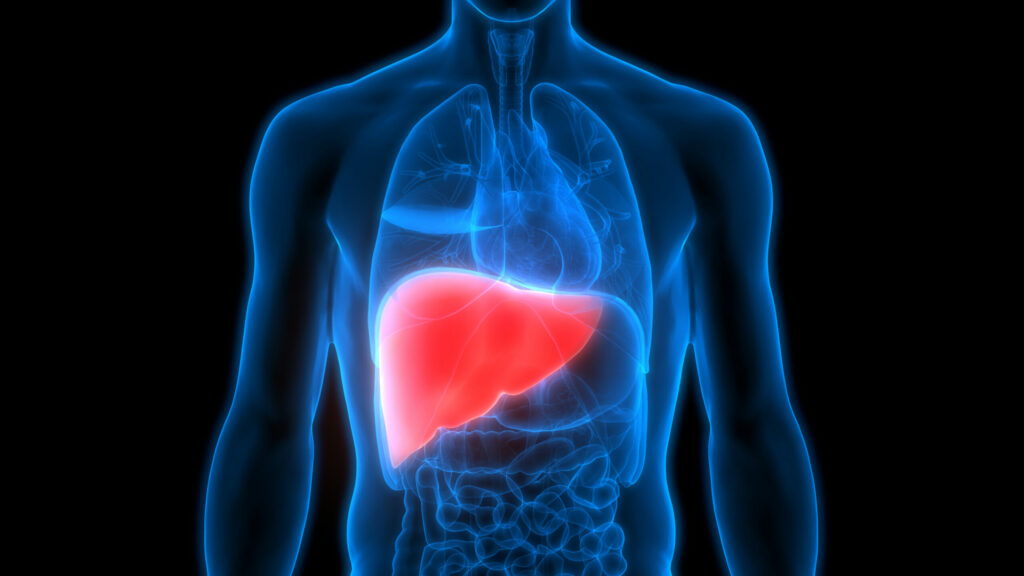According to the CDC, from 2000 to 2018, death rates for chronic liver disease and cirrhosis increased 31%.
A scary thought, to say the least, but don’t throw in the towel just yet. Researchers have found that the vast majority of cases of liver disease could be prevented when treated early.
Here are 13 red flags that could indicate something serious…
Coated Tongue

The tongue is a great indicator of the health of a person’s liver and digestive system. Pink and smooth usually mean healthy. If it has a white, yellow, or brown coating, then there could be a problem.
A coated tongue is a sign that your body isn’t digesting food properly, allowing bowel bacteria and yeast like candida to overgrow. The liver helps with the digestion of fat by producing bile. When there are problems with the vital organ, we don’t produce enough bile for proper digestion. This can cause symptoms and complications.
Body Odor

Bad BO can be caused by liver problems. Many times, the person affected is not able to smell the offensive odor, but friends, family members, or colleagues may bring it to your attention.
Liver disease can cause excessive sweating with activity and change the consistency of body sweat in men and women, resulting in an unpleasant smell. The odor is often described as being pungent and somewhat similar to that of rotten eggs, although it may be more subtle in some people. It depends on the problem and the individual.
The liver is responsible for filtering blood from the digestive tract before passing to it to the body. It also detoxifies chemicals as it secretes bile that goes to the intestines. When the organ isn’t working as it should, these functions are interrupted, and toxins can unpleasantly come to the surface. The result is a foul odor, among other symptoms.
DARK CIRCLES UNDER THE EYES

Dark circles under the lower eyelids are rather common in both men and women. Often accompanied by bags (mild swelling or puffiness), they can occur due to natural aging, fatigue, dehydration, allergies, or overexposure to the sun, but they can also appear as an external manifestation of a liver disease, which may require treatment.
In a significant percentage of people with liver problems, dark circles become visible under the eyelids. These circles are unsightly and can make a person look worn. Individuals with liver inflammation tend to have especially dark under-eye circles. When the underlying issue is liver disease, though, there are usually other symptoms.
According to medical experts, it is unlikely that liver disease is the cause of the dark circles under your eyes unless there are co-symptoms, such as body odor and a coated tongue. That being said, under-eye circles shouldn’t be ignored, and if your body starts changing in unusual or suspicious ways, then it’s important to consult your doctor.
PALE STOOLS AND IRREGULAR BOWEL MOVEMENTS

While every person’s bowel movements are unique, stools generally range in hues of brown, and when you have liver disease, the color of your stools may change. Typically, they will have a pale appearance.
Pale or clay-colored stools indicate a problem with the biliary tract, which comprises the liver, bile ducts, and gall bladder. The liver releases bile salts into stools. This is what gives them a brown color. But if the liver is not producing enough bile or bile flow is blocked and not draining as it should, then your stools may become pale.
Constipation is common with diseases of the liver, where one may not be able to pass stools regularly or completely empty their bowel. With constipation, your stools may also be hard and lumpy and/or unusually large or small. In some cases, people with liver problems may experience irritable bowel syndrome (IBS) symptoms.
BAD BREATH

Diseases that affect the liver don’t just cause bad body odor; they can also cause really bad breath. In the medical community, this symptom is known as fetor hepaticus. It is also known as hepatic fetor.
Fetor hepaticus is characterized by a strong, musty smell that some people describe as having a sweet and fecal odor. It occurs when the liver struggles to naturally filter out toxins, allowing sulfuric substances to infiltrate the bloodstream and ultimately end up in the lungs. These substances give your breath a foul odor when you exhale.
Hepatic fetor is sometimes referred to as the “breath of the dead.” This is because there is an association between fetor hepaticus and severe liver disease, which is often fatal. The foul smell is considered a late sign of liver failure among healthcare professionals, although fetor hepaticus may rarely occur as an early symptom of liver disease.
ITCHY PALMS AND SOLES

Are the palms of your hands and soles of your feet constantly itchy, and you can’t figure out why? It could be due to pruritus caused by liver disease, and the itching won’t stop until you treat the main condition.
Stubborn itchiness in the hands and feet can be a symptom of primary biliary cholangitis (PBC), also known as primary biliary cirrhosis. This is an autoimmune disease that affects the liver. It features progressive inflammation, destruction of the liver’s small bile ducts, and irreversible scarring (cirrhosis), making it difficult for the liver to function.
In people with primary biliary cholangitis, itching is incredibly common and may occur early in the course of the disease. Usually, it begins in the palms and soles and then spreads to other body areas. The itching, which can be extremely intense, tends to worsen at night and improve during the day, but this isn’t always the case.
JAUNDICE

Yellow discoloration of the skin and the white part of the eyes is called jaundice. This is a well-known symptom of many dangerous cancers and serious diseases or problems involving the liver.
Jaundice (also known as hyperbilirubinemia) occurs when there is an accumulation of bilirubin, a yellow-brown substance found in the liver’s bile. Bilirubin that can’t move through the liver and bile ducts quickly enough due to a blockage or disease builds up in the blood and is deposited in the skin. The result is jaundice.
The most common liver-related causes of jaundice are hepatitis and alcoholic liver disease. Hepatitis damages the liver, making it less able to move bilirubin into the bile ducts. Alcoholic liver disease has similar effects. Sometimes, primary biliary cholangitis can cause bile duct blockages, resulting in a buildup of bilirubin in the bloodstream.
NAUSEA

Nausea and loss of appetite, which can lead to weight loss, are some of the most common symptoms of liver damage. Actually, the initial stages of hepatitis have been known to cause flu-like symptoms like digestive discomfort in some individuals. But, nausea can be caused by many different things, so it’s important to get a proper diagnosis.
Causes of nausea not related to liver disease include overeating, food poisoning, pregnancy, intense pain (from injuries or certain health conditions), motion sickness, and emotional stress. Ulcers, infections, bulimia, or other psychological illnesses are other possible causes. Some medications and drugs can also bring on nausea.
Medications that can cause nausea as a side effect include aspirin, antibiotics like erythromycin, nonsteroidal anti-inflammatory drugs like ibuprofen and naproxen, and blood pressure drugs like nifedipine.
HORMONAL IMBALANCE

A productive organ, the liver has many important functions inside the body. One of those functions is to repeatedly break down and eliminate (metabolize) hormones once they have served their purpose.
The liver is responsible for metabolizing aldosterone, sex hormones, and cortisone. Aldosterone controls the balance of sodium, potassium, and water, while our sex hormones and cortisone control our sex life, body shape, and immune system. When the liver cannot metabolize these hormones efficiently, the result is hormonal imbalance.
Hormonal imbalances that occur due to liver disease or liver damage can cause a variety of physical changes and symptoms. Men can develop gynecomastia and withered testicles and lose hair. Women may grow excess hair on the body or face, have their menstrual cycles disrupted, and experience heavy, painful menstrual bleeding.
FATIGUE

Fatigue is an extremely common symptom of liver disease, affecting those with issues that range from primary biliary cirrhosis to chronic hepatitis C. Moreover, it occurs as commonly in the early stages of liver disease as it does in the most advanced stages.
The fatigue that occurs with liver disease can be incredibly bothersome. Often, it affects the quality of life to a large degree, and in many cases, it is completely debilitating, causing lethargy, exhaustion, and malaise. Some men and women with liver disease fatigue even seek psychiatric assessment, as depression can be an accompanying symptom.
Tiredness relating to liver problems can occur at any time during the day, but many sufferers report experiencing extreme fatigue in the mornings approximately an hour after waking up. One can literally feel exhausted by the time their day starts. Others describe feeling weak and lethargic throughout the day and must take afternoon naps.
ABDOMINAL PAIN

A lot of men and women living with liver disease experience pain in the abdominal area. This is referred to as liver pain. Over one hundred liver diseases and disorders can cause liver pain.
Hepatitis (liver inflammation), cholangitis, and hepatomegaly are a few examples of liver conditions that can cause abdominal pain. Liver cirrhosis, liver failure, liver abscesses, liver cancer, and Budd-Chiari syndrome are other known causes of liver pain and discomfort.
Pain caused by problems involving the liver is typically felt in the upper right section of the abdomen, directly below the ribs. It tends to be a dull, vague, and persistent pain, although it can sometimes be sharp and acute and occur sporadically, radiating to the back and the shoulder. Many sufferers report feeling pain in the right shoulder region.
SPIDER ANGIOMAS

Spider angiomas (aka spider nevi) are small clusters of dilated blood vessels that can be seen just below the surface of the skin. They are called spider angiomas because they normally have a central point with vessels that extend outward, resembling a spider’s web.
In adults, spider angiomas usually appear on the face, neck, arms, and upper part of the body. Children may also develop spider nevi in these areas but are more likely to get them on the hands and fingers. The marks can be caused by physical injuries, exposure to the sun, and hormonal changes. They can also be a symptom of liver disease.
When the cause is related to diseases of the liver, there is typically more than one spider angioma visible on the body. Applying pressure on the angiomas with your fingers makes them disappear, and when pressure is released, they reappear as blood flows back into the small vessels. The thin, web-like vessels may be blue, red, or purple in color.
COGNITIVE DECLINE

Brain function deterioration has been observed in people with all kinds of liver diseases, including alcoholic liver disease, hepatitis C, primary biliary cirrhosis, and Wilson’s disease. Sometimes, the deterioration is mild or just barely detectable. Other times, there is noticeable hepatic encephalopathy and severe cognitive dysfunction.
Hepatic encephalopathy causes symptoms such as confusion, memory loss, difficulty focusing, and disorientation. The affected individual may also have slower reaction times, struggle to solve basic math problems, and experience personality changes. In extreme cases, slurred speech, arm/leg jerking, and unresponsiveness may occur.
The cause of hepatic encephalopathy is not clear, but brain function decline may occur due to central nervous dysfunction and a buildup of toxic substances in the brain. These substances include ammonia, free fatty acids, and false neurotransmitters. Studies indicate that up to 70 percent of people with liver cirrhosis develop hepatic encephalopathy.







